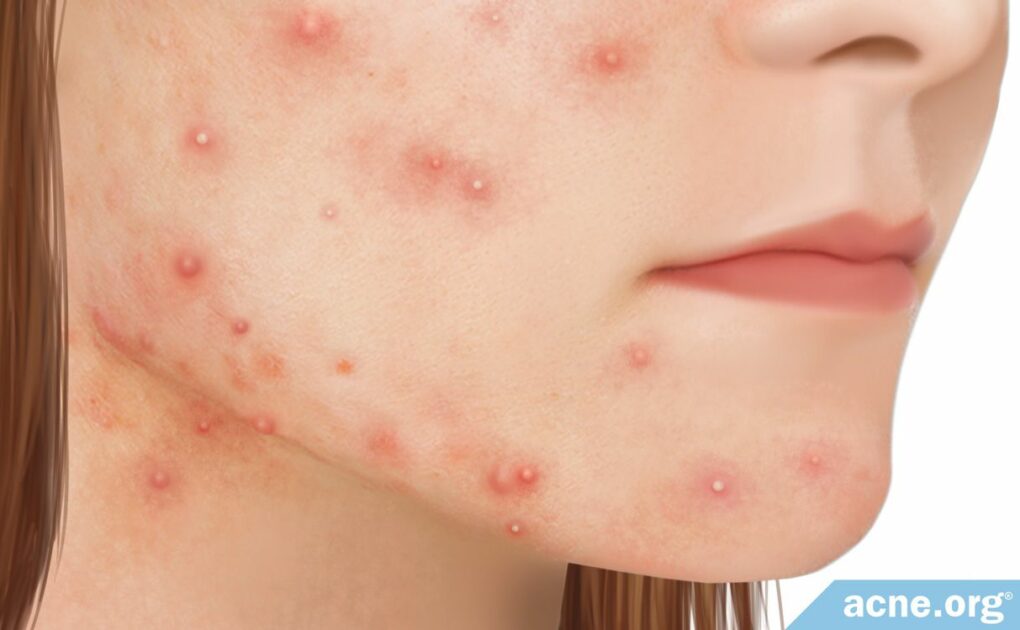Adult Females Tend to Develop Acne on Their Entire U-zone, Which Includes the Chin, Cheeks, and Jaw

The Essential Info
Women are more likely to suffer from adult acne than men, largely because of hormone changes that occur with menstrual cycles.
Although many people believe that adult female acne affects the chin most often, studies show acne affects the chin, cheeks, and jaw. In fact, the evidence shows that acne presents on the cheeks and jaw area even more frequently than on the chin.
The reason women tend to mention “chin acne” is probably because when we look straight at ourselves in the mirror, the chin area is simply more noticeable than the cheeks or jaw.

The Science
- Where Adult Female Acne Tends to Occur: the U-zone
- The Studies: The Cheeks Are Most Affected, Followed by the Chin, and Then the Jaw
- How to Treat Adult Female Acne
People think of acne as largely a teenage problem. However, even in adulthood, many women continue to experience acne breakouts 7-10 days before the onset of menstruation because of normal hormone changes that happen with menstrual cycles. This is known as premenstrual acne, and it afflicts 36-78% of women, particularly women over 30 years old.
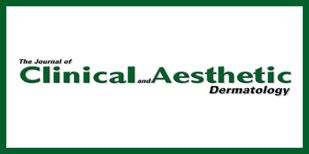
Authors of a 2017 study published in the Journal of Clinical and Aesthetic Dermatology noted, “The rate of premenstrual [a.k.a. “hormonal”] acne flares has been found to be significantly higher in women over 30 years of age compared to younger women.”1
Where Adult Female Acne Tends to Occur: the U-zone
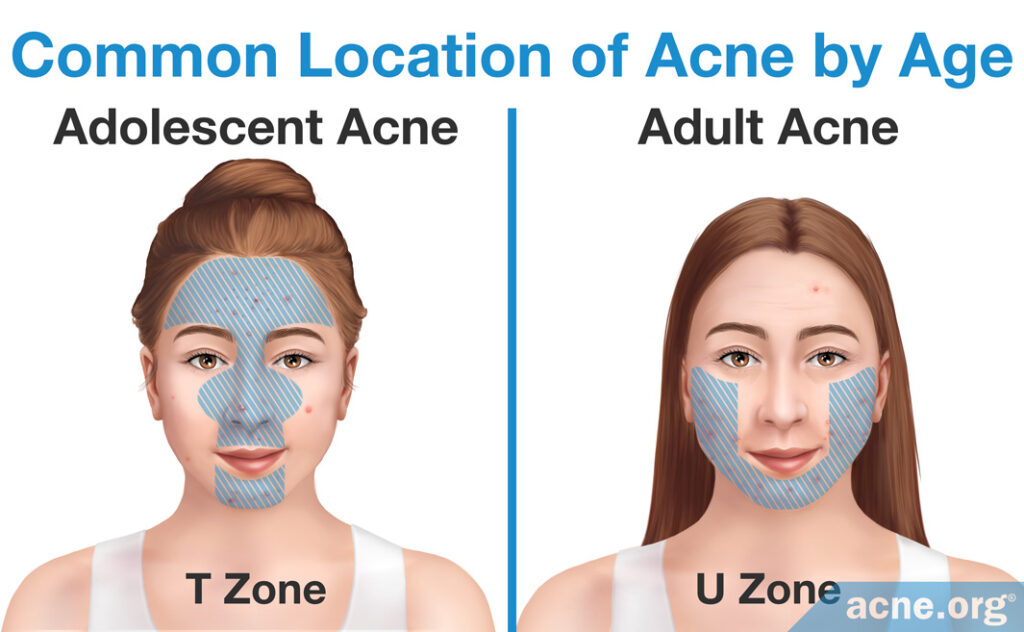
The chin, cheeks, and jaw areas combined are known as the “U-zone,” and the forehead and nose areas are known as the “T-zone.” Adult women are more likely to have acne in the U-zone, while adolescent females are more likely to have it in the T-zone.
Many adult women simply refer to the affected U-zone acne as “chin acne.” This is likely because the chin is the part of the U-zone that is easiest to see when looking directly in the mirror. But studies show that adult women are just as likely, if not more likely, to experience acne on the cheeks and jaw areas too.2-6
Adult female acne tends to present primarily as inflamed pimples, the ones that are red and sore, while adolescent female acne is more likely to present with all types of acne, including non-inflamed, less red and sore pimples, called whiteheads and blackheads.6,7
In fact, research suggests that adult female acne differs from adolescent female acne in 2 other ways as well:
- Females with adult acne tend to have very sensitive skin, while those with adolescent acne do not.
- Not all females with adult acne have oily skin, but females with adolescent acne do.8
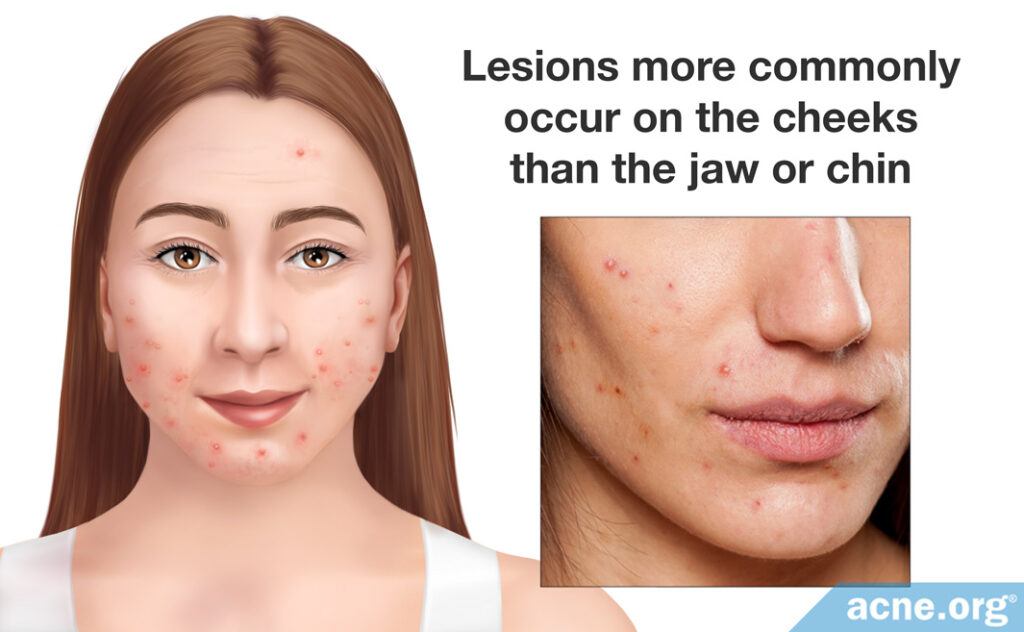
The Studies: The Cheeks Are Most Affected, Followed by the Chin, and Then the Jaw
The following four studies show that adult female acne is common in the U-zone, particularly on the cheeks. According to the studies, this is seen worldwide, especially in people with darker skin types.
The first study shows us that the cheeks are affected most often, followed by the chin, and then the jaw.

A 2012 study published in the Indian Journal of Dermatology, Venereology and Leprology found that adult female acne affects the cheeks most often, followed by the chin, and then the jaw. The study included women and men over the age of 25 who had acne. The average age of women and men in this study was 30.5 years. Among the 230 women included in the study, 83% reported acne on the cheeks; 71% reported acne on the chin, and 61% reported acne on the mandible (jaw area). As indicated from these numbers, many women reported having acne in more than one area of the face. Percentages for men were lower, especially for the chin and jaw.3
The second and third study reiterate that the cheeks are most prone to adult female acne, followed by the chin.
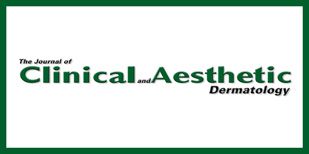
A 2014 study published in the Journal of Clinical and Aesthetic Dermatology also showed that women were more likely to have acne on the cheeks than the chin. This study compared Caucasian and non-Caucasian women. Among Caucasian women, 28% were found to have acne on the chin, and 31% were found to have acne on the cheeks. For non-Caucasian women, only 12% had acne on the chin, while 58% had acne on the cheeks.4
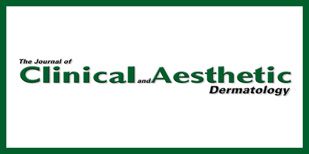
Another study, also published in the Journal of Clinical and Aesthetic Dermatology in 2014, obtained similar results. The researchers looked at 208 adult women of different ethnicities in the United States who suffered from acne. The women were between the ages of 25 to 45 with an average age of 35. The researchers found that 79.8% of the women had acne on the cheeks, 77.9% had acne on the chin, and 77.4% had acne on the forehead.9
And the fourth study shows us that adult women almost always see acne on multiple parts of the face. By this point, we are seeing clearly that “chin acne” is a misnomer. Adult women see acne on more than one part of their face and actually see it more on the cheeks than the chin.10
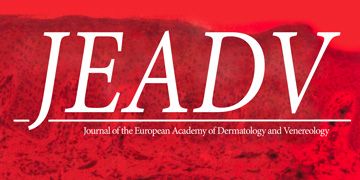
A 2015 international study published in the Journal of the European Academy of Dermatology and Venereology also found that the cheeks, chin, and jaw were the most likely areas for acne to appear in women. This study included 374 women from 15 countries over the age of 25, with an average age of 32. The study also reported that 90% of women with acne had acne in more than one area of the face.5
Here is an overview of all four studies:
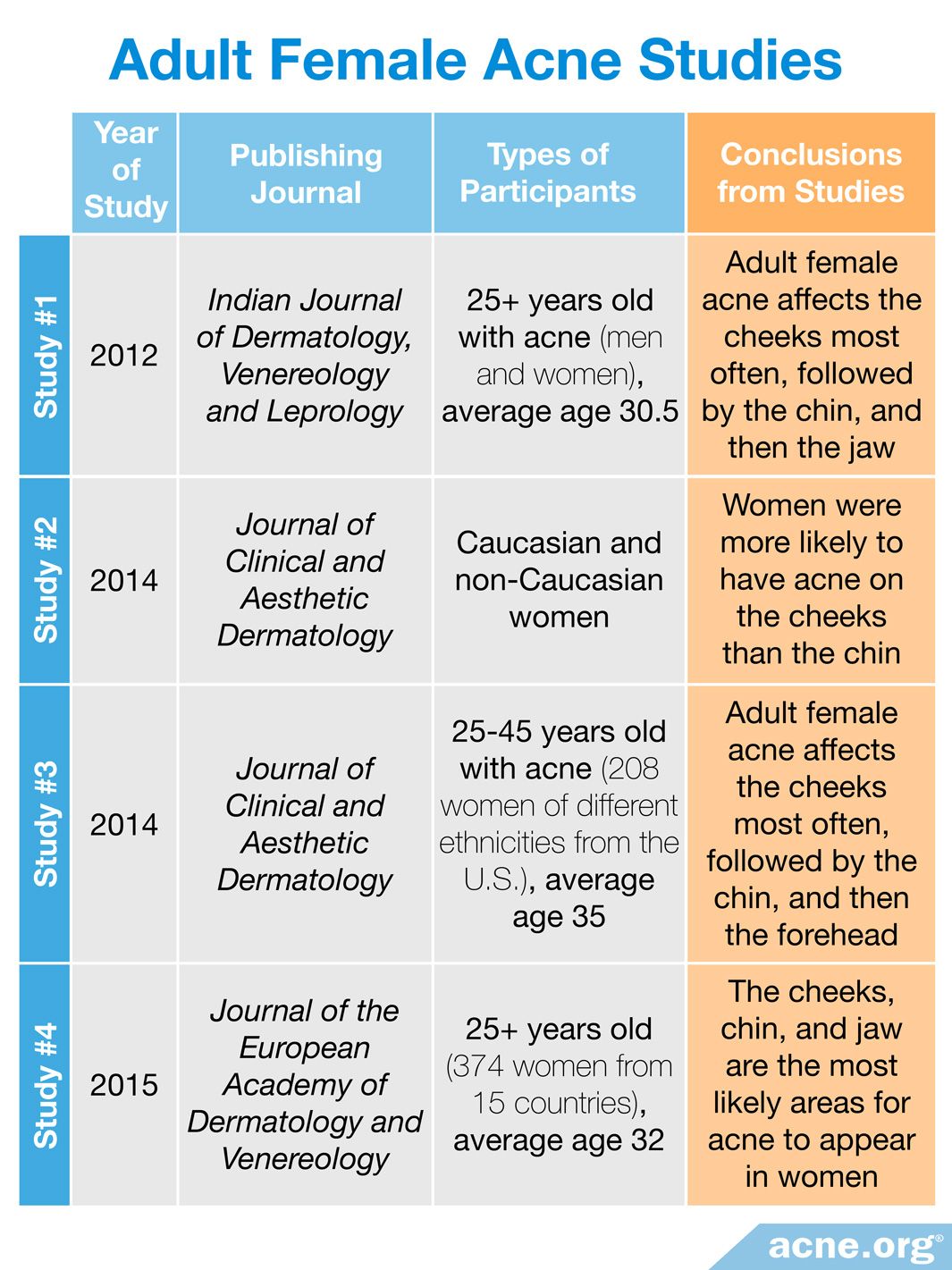
How to Treat Adult Female Acne
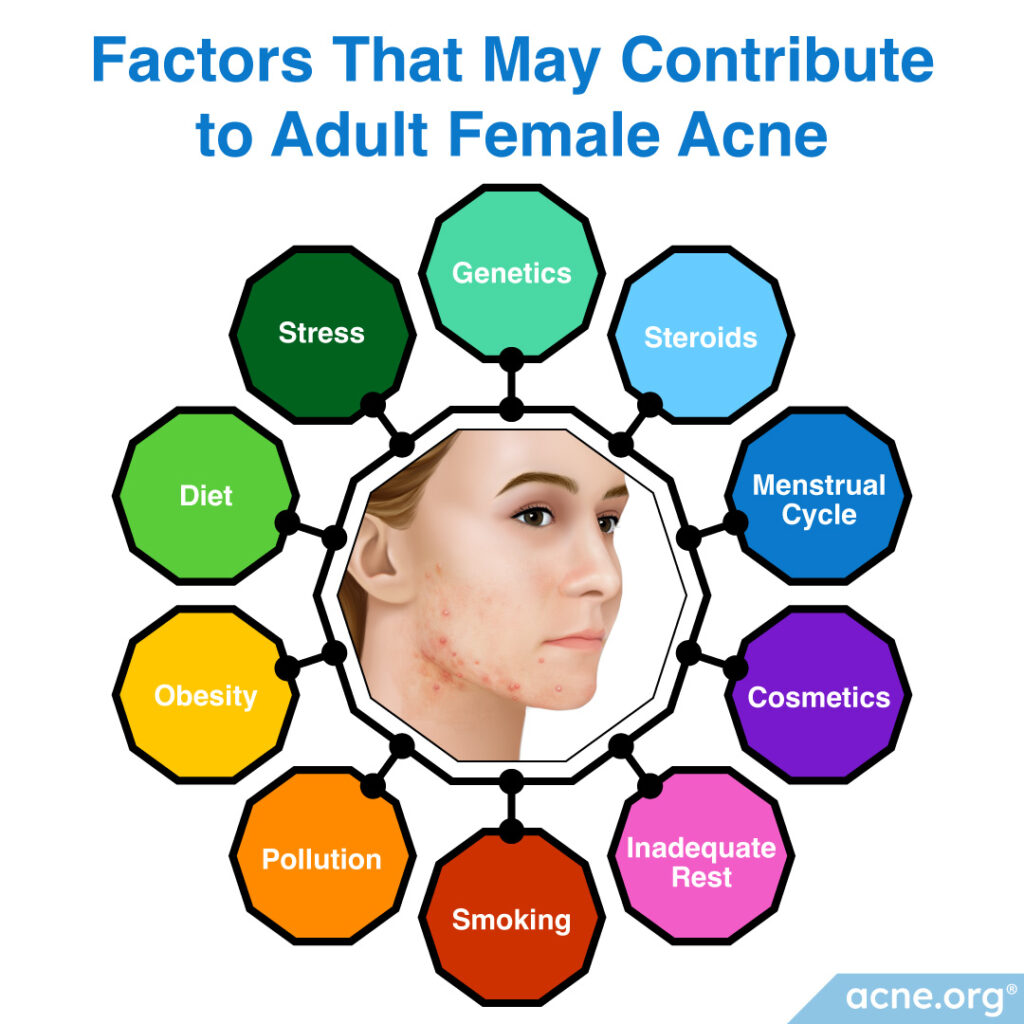
Treating acne in women is similar to treating acne in adolescents, but adult acne can sometimes be more stubborn to respond to treatment than adolescent acne.1,7
Oral contraceptives (birth control pills) can regulate hormones and thus can be effective in reducing premenstrual acne, but can come with side effects, so it’s important to always consider this treatment carefully alongside a trusted physician.
Topical agents like benzoyl peroxide and retinoids (tretinoin, adapalene, tazarotene) can also be effective in treating adult female acne.1,11,12
Prevention: Women can make strides in preventing acne by properly using cosmetics, reducing stress, keeping body weight in check, getting plenty of sleep, eating well, and not smoking.13
References
- Zeichner, J. A. et al. Emerging issues in adult female acne. J Clin Aesthet Dermatol 10, 37 – 46 (2017). https://www.ncbi.nlm.nih.gov/pubmed/28210380
- Albuquerque, R. G., Rocha, M. A., Bagatin, E., Tufik, S. & Andersen, M. L. Could adult female acne be associated with modern life? Arch Dermatol Res 306, 683 – 688 (2014). https://www.ncbi.nlm.nih.gov/pubmed/24952024
- Khunger, N. & Kumar, C. A clinico-epidemiological study of adult acne: Is it different from adolescent acne? Indian J Dermatol Venereol Leprol 78, 335 (2012). https://www.ncbi.nlm.nih.gov/pubmed/22565434
- Callender, V. D. et al. Racial differences in clinical characteristics, perceptions and behaviors, and psychosocial impact of adult female acne. J Clin Aesthet Dermatol 7, 19 – 31 (2014). https://www.ncbi.nlm.nih.gov/pubmed/25053980
- Dréno, B. et al. Large-scale international study enhances understanding of an emerging acne population: Adult females. J Eur Acad Dermatol Venereol 29, 1096 – 1106 (2015). https://www.ncbi.nlm.nih.gov/pubmed/25296739
- Choi, C. W. et al. The clinical features of late onset acne compared with early onset acne in women. J Eur Acad Dermatol Venereol 25, 454 – 461 (2011). https://www.ncbi.nlm.nih.gov/pubmed/20659307
- Dréno, B. et al. Adult female acne: A new paradigm. J Eur Acad Dermatol Venereol 27, 1063 – 1070 (2013). https://www.ncbi.nlm.nih.gov/pubmed/23302006
- Bagatin, E., Rocha, M. A. D. D., Freitas, T. H. P. & Costa, C. S. Treatment challenges in adult female acne and future directions. Expert Rev Clin Pharmacol 14, 687-701 (2021). https://pubmed.ncbi.nlm.nih.gov/33957838/
- Tanghetti, E. A., Kawata, A. K., Daniels, S. R., Yeomans, K., Burk, C. T., Callender, V. D. Understanding the burden of adult female acne. J Clin Aesthet Dermatol 7, 22 – 30 (2014). https://www.ncbi.nlm.nih.gov/pubmed/24578779
- Rocha, M. A. & Bagatin, E. Adult-onset acne: prevalence, impact, and management challenges. Clin Cosmet Investig Dermatol 11, 59 – 69 (2018). https://www.ncbi.nlm.nih.gov/pmc/articles/PMC5798558/
- Sweeney, T. M., Szarnicki, R. J., Strauss, J. S. & Pochi, P. E. The effect of estrogen and androgen on the sebaceous gland turnover time. J Invest Dermatol 53, 8 – 10 (1969). https://www.ncbi.nlm.nih.gov/pubmed/5793140
- Wiegratz, I. & Kuhl, H. Managing cutaneous manifestations of hyperandrogenic disorders: The role of oral contraceptives. Treat Endocrinol 1, 373 – 386 (2002). https://www.ncbi.nlm.nih.gov/pubmed/15832490
- Yang, J., Yang, H., Xu, A. & He, L. A review of advancement on influencing factors of acne: An emphasis on environment characteristics. Front Public Health 8, 450 (2020). https://pubmed.ncbi.nlm.nih.gov/33042936/
 Acne.org Products
Acne.org Products